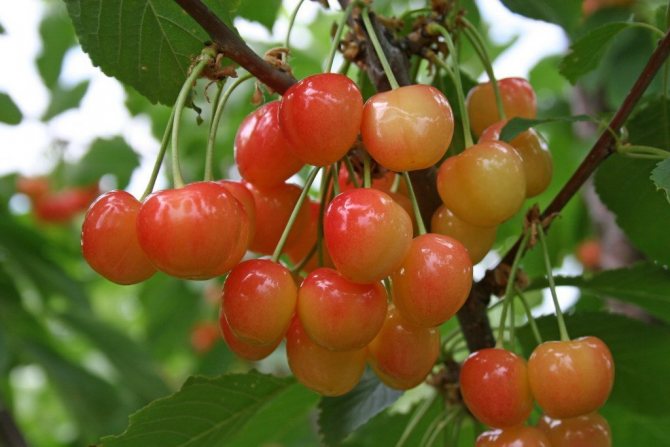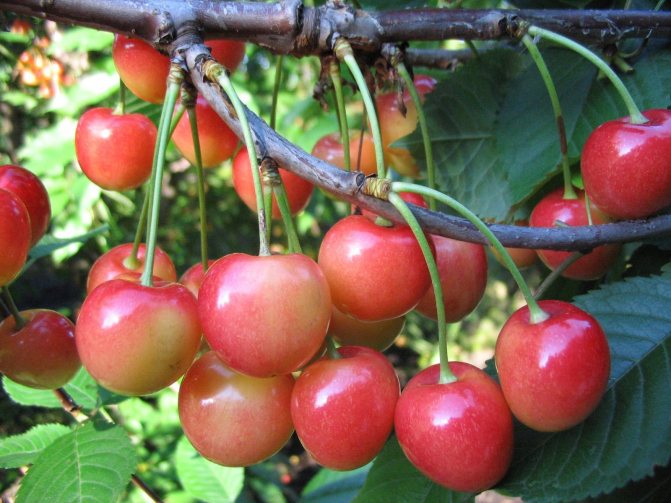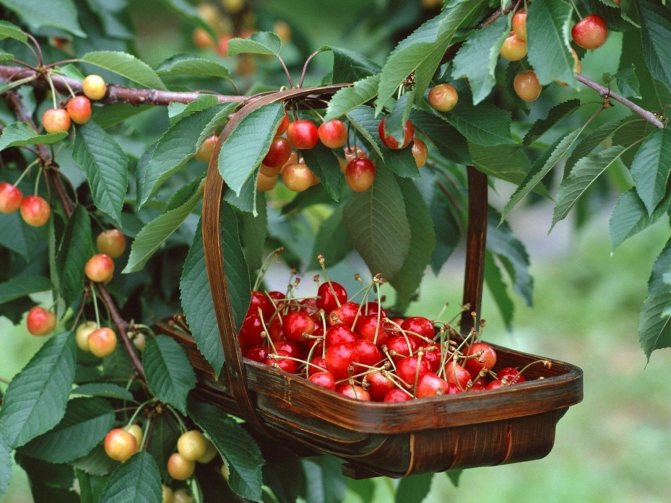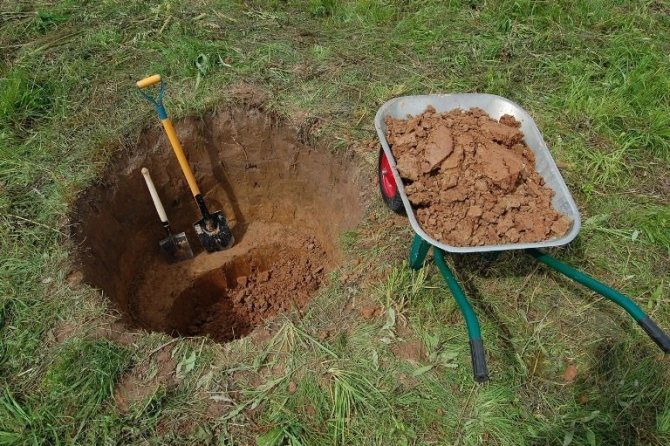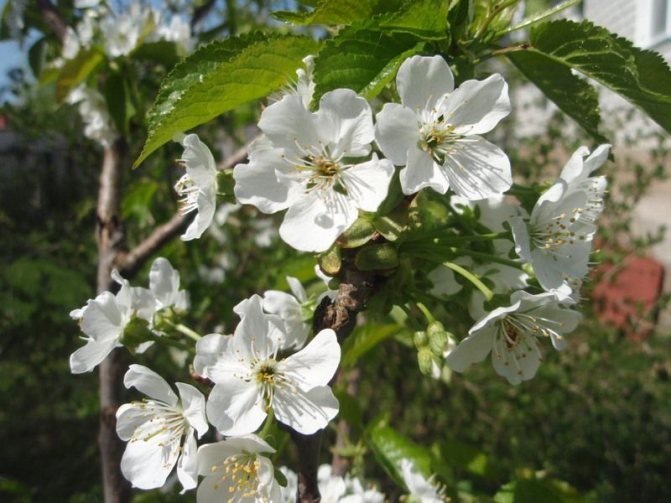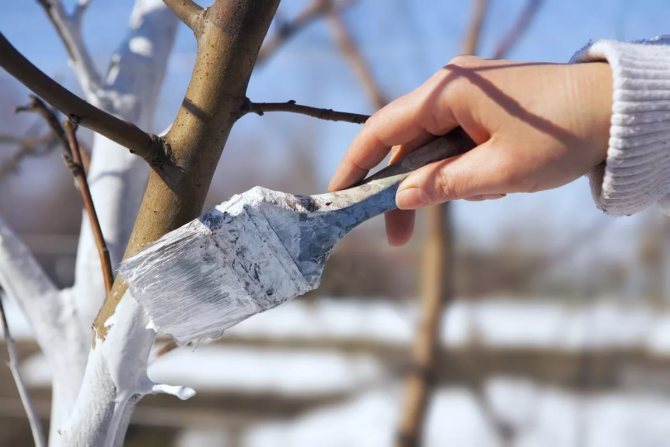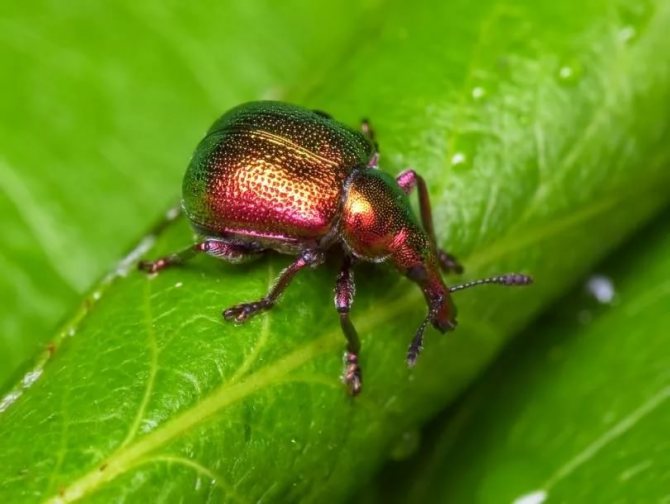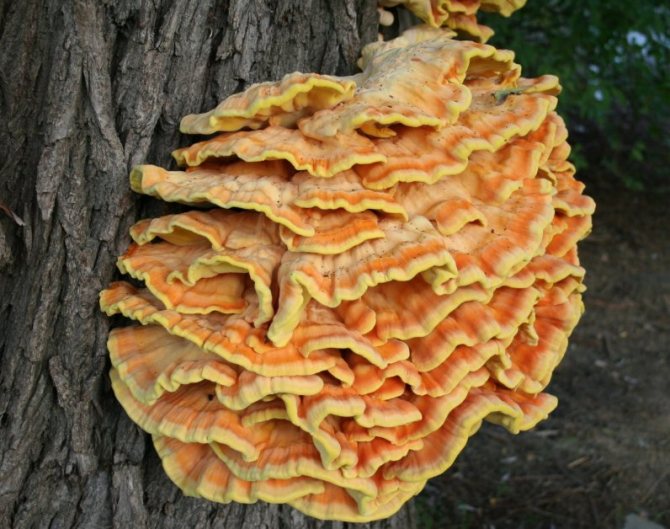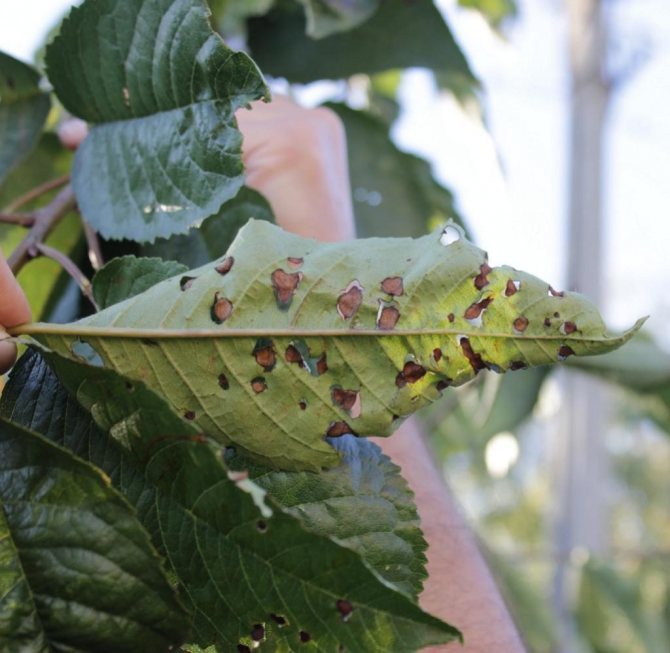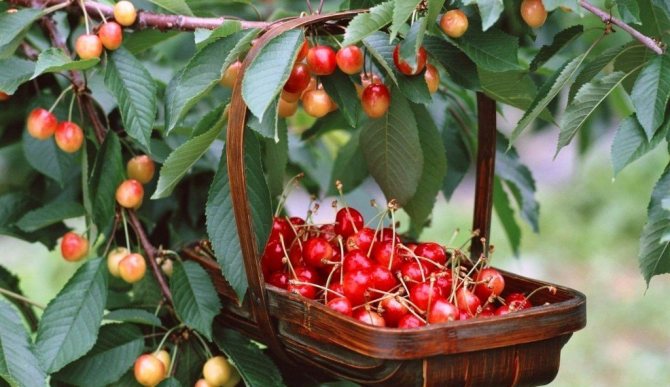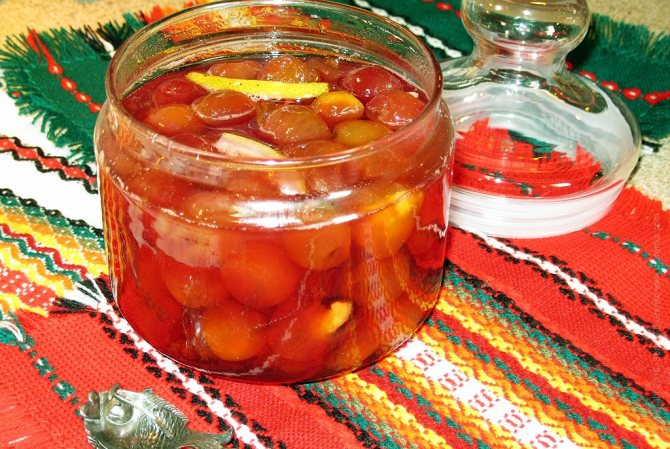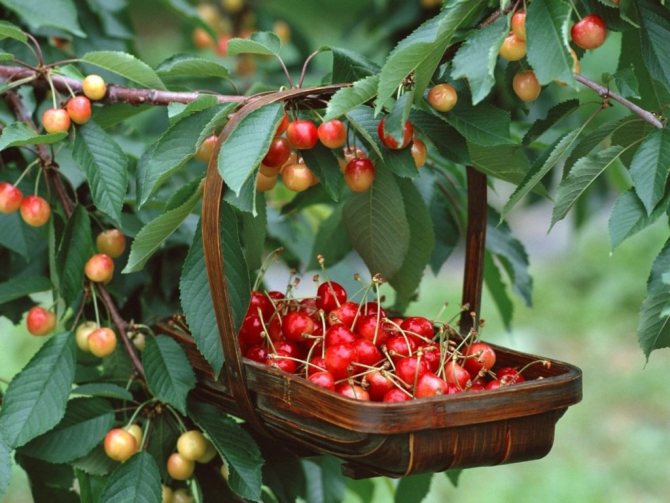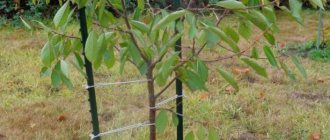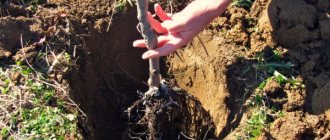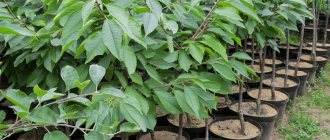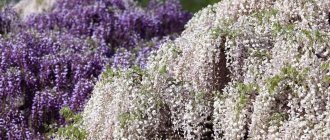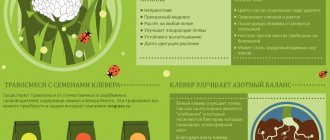Botanical description of the variety
Bryanskaya Rosovaya is a late-ripening hybrid of sweet cherry, bred within the walls of the All-Russian Research Institute of Lupine (Bryansk region). The basis of the new hybrid was the Cherry Muscat Black seedlings, which, due to long-term selection work, were transformed into a new, high-yielding hybrid. The variety has been zoned for cultivation in the conditions of the Central climatic region (the territory of the Bryansk region and adjacent areas).

Sweet cherry Bryanskaya Rosova is a typical representative of the Rosovye family. It is a plant with a straight trunk and a spreading crown, belonging to the trees of the first size. Sweet cherry is characterized by rather rapid growth and begins to bear fruit 5 years after planting.
The tree has 2 types of shoots: auxiblasts and brachyblasts. The first are distinguished by pronounced internodes, as well as large sizes. The latter are shortened processes with weakly expressed internodes. Flower buds often develop on them, which is a characteristic feature of all representatives of the culture.
Cherry is considered to be a close relative of the more common cherry, but it has some characteristic features. First of all, the tree is distinguished by a tall stem with whorled branches. Also cherry has more elongated and bright leaves, strongly pointed at the edge.
Did you know? Sweet cherry is one of the oldest fruit trees. The history of cultivation of this plant as a separate species has more than 2 thousand years.
Testimonials
Bryanskaya Pink is inferior in taste to Sinyavskaya, but surpasses in yield.
z9091946
Iput and Bryansk pink. That frosty winter we had a great winter.
marina-bal
I planted Bryansk pink, froze out last winter, although it was wrapped, BUT I have a left bank. Friends in the Bogorodsky district have cherries.
Alena70
Yes, I don’t know how to say which is better, because almost all cherry varieties are self-fertile (that is, they require pollination with another variety), only some have partial self-fertility. Therefore, to set fruit, it is imperative to plant several varieties. I chose according to the timing of fruiting, Iput - early ripening, Bryansk pink - late ripening.
marina-bal
Bryansk pink is excellent for growing in the Central region of Russia. Novice and experienced gardeners should try this variety, its positive qualities will be appreciated.
Hello! My name is Anatoliy. I am 46 years old, a mining engineer by profession. I am married and have two children. Rate the article:
- 5
- 4
- 3
- 2
- 1
(0 votes, average: 0 out of 5)
Share with your friends!
Characteristics of berries and wood
This hybrid is characterized by small size (up to 3.5 m in height), as well as a restrained type of growth. On an even cylindrical stem, a raised, rather strong and dense wide-pyramidal crown is formed. It is formed by even branches with a smooth surface, light brown in color. They are directed at an acute angle relative to the trunk.


Small fruits of Bryansk pink have a dense pink-yellow skin and light flesh.
The plant blooms profusely, at this time three-flowered inflorescences are formed on it.Individual flowers are small, white, the petals in the flowers are free. The ovary is formed on annual or bouquet branches. It transforms into small stone fruits. The fruits of the plant are small, rounded, weighing up to 6 g, pink-yellow in color. The average size of one ripe berry is 2.1 × 2 cm (W × H).
The flesh of the fruit is yellow, juicy but firm when cut. The taste features of the pulp are excellent: it is quite sweet, with moderate sourness and light bitterness. The tasting characteristic of the crop is about 4.1 points. The berries are characterized by excellent keeping quality, so the harvest is suitable for long-term transportation.
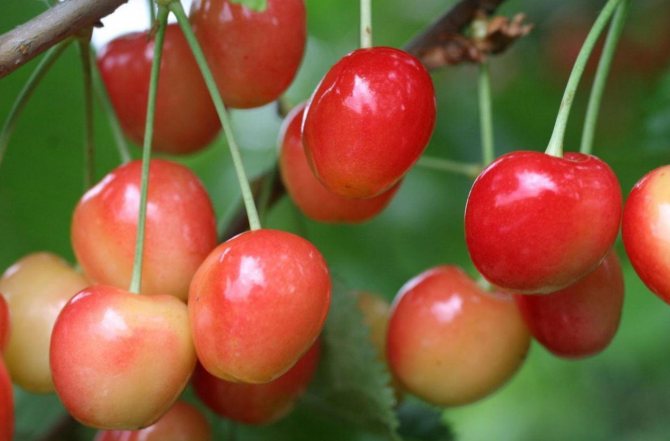

The average yield of a tree is in the range of 20-25 kg / plant, which is about 60 kg / ha
Sweet cherry for the Moscow region - the best varieties of the middle zone of agriculture
You can find out which varieties of cherries are suitable for growing in your region on the website of the state register.
We really hope that we helped you find a suitable cherry nursery, in which you will purchase the planting material you need.
How to choose a good cherry sapling
Cherry has a very powerful root system, and it is quite difficult to dig out a two-year-old seedling. Therefore, the vast majority of nurseries sell only annual seedlings of this culture. Only a very small number of plants are left for the so-called rearing.
So, the height of an annual cherry seedling, as a rule, is about 1.5 meters, it has a well-developed lobe of roots and 2-4 branching shoots.
Sometimes it happens that a cherry seedling has no branches at all. This is normal if the thickness of the trunk is at least 2-2.5 cm (while the thickness of the seedling with branches is 1.8-2 cm). So you should not be afraid to buy an unbranched seedling. After planting, you just need to book it, that is, cut off the top of the head 20 cm above the kidney.
The seedling should not show signs of disease, traces of lichens, broken or cut branches.
In accordance with GOST, there should be no leaves on the seedling. In a good nursery, the seedlings are scrubbed (remove all the leaves) even before they are dug up.
In order to check if the roots and shoots are dry, it is necessary to bend a small root into a ringlet. It should roll up without crunching and be “alive” to the touch - wet, whitish-green in color. Examine the shoots, too, try to bend them - the live ones bend well and do not crunch, and the bark at the fold gathers into an "accordion", but does not exfoliate.
When is the best time to plant - in spring or autumn
It is better to plant cherry seedlings in a permanent place in the spring, at which time the soil is rich in moisture and there is a long season ahead so that the tree gains strength before wintering.
Even in a specialized nursery, you should not completely trust the opinion of the seller. It is necessary to independently inspect the plant, its root system and shoots, and buy a seedling only if it meets certain quality standards.
How to transport a seedling to the site
To do this, it is enough to purchase sawdust. They need to be well moistened, poured onto the bottom of the garbage bag and the roots of the seedling should be placed in it. It is better to sprinkle them on top with three or four handfuls of sawdust and tie the bag tightly. It is advisable to pack the roots so that they do not break through the bag, then there will be no evaporation of moisture and the seedling will easily reach its destination.
Healthy varietal seedlings are the foundation of a good garden. And their choice is worth working hard. Do not rush to buy the first thing that caught your eye, just because you need to plant plants on the site faster. Consider the choice of seedlings thoroughly. And a rich harvest from your young garden will not keep you waiting.
The most popular varieties of cherries
Cherry varieties Iput
- fantastic yield - up to 30 kg of fruits per tree; - extreme frost resistance - can withstand up to -32 degrees of frost; - resistant to fungal diseases; - partially capable of self-pollination. For a regular and good harvest, you need to plant next to the cherries of the varieties Ovstuzhenka, Raditsa, Revna, Bryanskaya pink.
Cherry varieties Fatezh
- the buds are not very frost-resistant, in contrast to the trunk and branches; - the yield can reach 30 kg per tree; - not susceptible to diseases, in particular - rot; - a self-infertile variety, you should choose Ovstuzhenka, Iput, Raditsa as neighbors.
Sweet cherry Bryansk pink
- the buds are not resistant to frost, and the trunk and skeletal branches are resistant; - due to the peculiarities of the crown, the tree practically does not need pruning; - high yield - up to 30 kg per tree4 - berries are not prone to cracking. - not capable of self-pollination, Ovstuzhenka, Revna, Tyutchevka, Iput should be planted in the neighborhood.
Cherry Revna
partially self-fertile variety, but for abundant fruiting it is necessary to plant in tandem with Tyutchevka, Iput, Raditsa, Ovstuzhenka; - winter-hardy variety, not susceptible to diseases; - excellent for transportation and freezing; - excellent, abundant fruiting - up to 30 kg of fruits from one tree.
Drogan yellow cherry variety
- Drogan's cherry tree, yellow, tall, with a spreading crown. Consider this if the site is small; - very thin skin of the fruit. On the one hand, it is much more pleasant to eat berries with a delicate skin, on the other hand, such cherries are poorly suited for transportation or freezing, and the fruits can crack on the tree. The bone does not separate from the pulp; - high productivity. Moreover, all the fruits reach at the same time, do not fall off on their own; - high drought resistance and frost resistance; - Drogana Yellow is not a self-pollinated variety, so cherries of other varieties will need to be planted in the garden.
Cherry Rival
A medium-ripening variety, self-fertile, requires a pollinator. The trees are medium-sized - up to 4 meters. Cherry seedlings Opponent allow you to annually collect a bountiful harvest of tasty large berries. The main color of the fruit is amber yellow, the coat is red. Berry weight up to 7 grams. The pulp is bright yellow, juicy, firm, sweet. Tasting score 4.8 points. The stone is medium in size, easily separated from the pulp. The variety is moderately hardy, resistant to coccomycosis.
Cherry Valery Chkalov
Early maturing variety. Zoned in the North Caucasus region (Stavropol Territory, Rostov Region, Republics: Ngushetia, Chechen, Karachay-Cherkessia). The height of the tree is 5-6 meters. The fruits are large, weighing 6-8 grams. The skin is thin. The juice is dark red. The purpose of the variety is universal. Most often it is used fresh and in cooking when making desserts; also berries are well suited for preservation. The level of early maturity is medium: fruiting begins in the 5th year from the moment the seedlings are planted.
Cherry Staccato
Canadian selection. Self-fertile, one of the latest cherry varieties. Ripens 7 days later than Sweethart variety. High productivity. Fruits weighing 12 grams, dark red, firm, sweet. Very resistant to cracking in the rain.
Cherry varieties for the Central region
For Bryansk, Vladimir, Ivanovo, Kaluga, Moscow, Ryazan, Smolensk, Tula regions, the following varieties of cherries are recommended: Bryanochka, Bryanskaya rosovaya, Veda, Gronkavaya, Iput, Lena, Lyubimitsa Astakhova, Ovstuzhenka, Odrinka, In memory of Astakhov, Stepanov Ryazan, Gift , Raditsa, Revna, Rechitsa, Sadko, Sinyavskaya, Teremoshka, Tyutchevka, Fatezh, Chermashnaya. All these varieties are included in the State Register for the Russian Federation and are allowed for cultivation in the Central Region.
Features and landing rules
Despite the preparedness of this cherry for a temperate climate, some rules must be followed during planting.They provide for the selection of the optimal landing dates and location on the site. Thanks to this, you can create a suitable microclimate in the garden, conducive to the active growth and fruiting of the tree.
Video: Instructions for planting cherries
Optimal timing
According to the general rules of agricultural technology for growing fruit trees, they are planted in early spring or late autumn. However, when planting Bryanskaya Rose, it is necessary to take into account some physiological characteristics of the plant, as well as the low cold resistance of the species. In this case, the best time to plant this cherry is early spring.
The procedure is started immediately after the top 50 cm soil layer is completely frozen. In the temperate climate zone, this period lasts from mid-February to mid-March.
Important! When planting cherries, the average daily temperature should not fall below + 5 ° C, otherwise the seedling may freeze out.
Seat selection
Cherry develops best in open and well-lit areas, protected from drafts. The most suitable for this are the southern and southwestern parts of the garden, located in a fence or on the sunny side of the garden buildings, at a distance of at least 5 m from the fence.
You can plant cherries near other fruit trees, while they should not shade the seedlings... Therefore, it is better to break the place for the hole no closer than 3 m from tall vegetation. Also, the culture does not like the lowland, therefore, in the tree planting zone, a small mound up to 50 cm high should be poured.


For planting cherries, the sunniest places are chosen, protected from sharp gusts of wind.
Site preparation
For the successful growth and development of sweet cherry Bryanskaya Pink requires a well-fertilized loamy substrate, prepared in a special way. This procedure is started approximately 2 weeks before planting.
How to grow cherries?
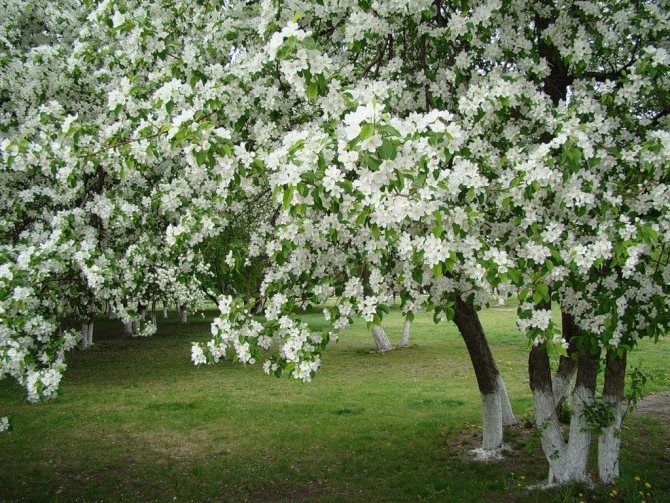

To obtain bountiful harvests of Bryansk pink sweet cherry, it is important to plant a tree correctly on your site.
How to choose a seedling?
It is recommended to buy a cherry seedling in the fall. At this time, a wide selection of varieties and plants themselves are presented on the market, from which it is easier to choose the most productive. The seedling must be carefully examined: the grafting site on it must be visible, otherwise the tree was grown from a seed and may not be varietal at all.
One-year (75 centimeters high) and biennial (1 meter high) trees are suitable for replanting. The root system of a sweet cherry seedling should be developed, strong and intact, with numerous branches. It is recommended to transport the tree by wrapping it in a damp cloth and a layer of oilcloth.
When to plant cherries?
Sweet cherries can be planted in autumn, but gardeners are still in a hurry to dissuade them from such a step, arguing their recommendation that large growths on a young cherry seedling are very vulnerable to low temperatures.
If the seedling can survive the winter, then it will have only the trunk by the spring. The Bryansk pink sweet cherry seedling purchased in the fall is recommended to be dug in until spring in a small groove and covered with snow.
Cherries are best planted in a permanent place of growth in early spring, when the snow finally melts. It is recommended to dig a hole for a cherry seedling in advance - as soon as the soil moves away from frost and you can start digging it. A tree planted in early spring by the period of the onset of autumn frosts will already be able to take root well, it will become a strong tree with a well-developed root system.
The planting process in the spring should not be delayed: a tree that has blossomed in an old place will not take root well in a new one, may be affected by various diseases and will not show growth until the end of the growing season.
Seat selection
Sweet cherries take root best in places where there are no cold northerly winds and a lot of sunshine. Having cut off the flowers, the wind can leave the gardener without a crop. Without sunlight, the tree and fruits do not develop well. Therefore, it is important to select areas with southern or southwestern slopes and plant a tree on the sunny side of the buildings.
Other trees in the garden should not obscure the seedling. When laying a cherry orchard between trees in one row, it is necessary to leave a distance of at least 3 meters, row spacing - at least 5 meters. At least 2 pollinators must be placed next to the Bryanskaya rose cherry. For planting cherries, a slightly elevated place is suitable, or you can fill in a small artificial mound.
Soil for planting
Cherries require fertile soil that is well permeable and does not retain water. Sandy and clayey soils are automatically excluded. Loamy soils that are well saturated with oxygen will do. Constant loosening and watering provides the tree with sufficient air and water. Groundwater should be at a depth of at least 1.5 meters. Otherwise, you will need to dig a drainage ditch.
Landing technology
Scheme:
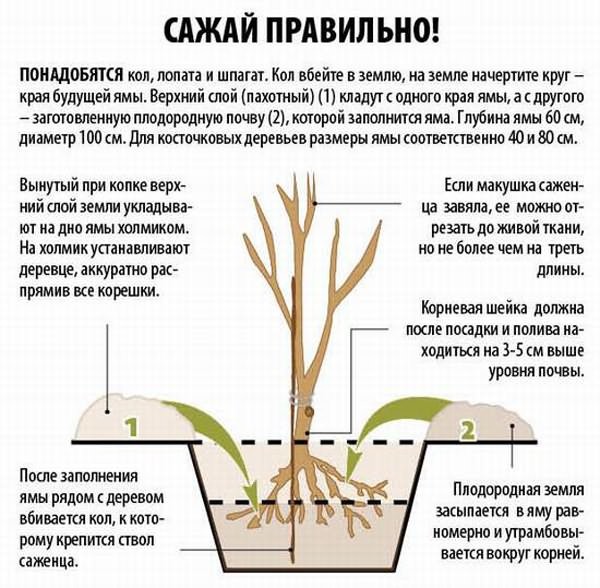

For planting sweet cherries of the Bryanskaya pink variety, it is recommended first of all to prepare the soil and dig a hole. The pit should be 60 centimeters deep and 70-80 centimeters in diameter. A nutrient composition is prepared from the topsoil 30 centimeters thick, 10 kilograms of transferred manure, 25 grams of potassium and 15 grams of phosphorus. If the soil is clay, add 900 grams of lime to it, loamy - 500 grams.
First of all, a stake must be dug into the bottom of the pit, which will become a support for the cherries. Further, the bottom of the pit in the form of a slide is covered with a mixture of soil and fertilizers and lightly tamped. A layer of non-fertilized ordinary soil is poured over it.
The tree must be re-inspected before planting. Dried roots are recommended to be immersed in water for 6-10 hours. Taking a seedling, they lower it into a hole and make sure that the root collar is 5 centimeters above the soil level.
The roots are slowly half covered with soil, the earth is compacted and a bucket of water is poured into the pit. Next, the pit is filled up to the end, compacted and a small roller is made to prevent water from spreading. The seedling is watered with 1-2 buckets of water.
After planting, the soil around the trunk of the sweet cherry should be mulched. It is best to use humus or peat for this. Moisture will remain in the ground longer and nourish the roots of the young tree.
Subtleties of wood care
To achieve ripening of high-quality and juicy berries, cherries must be carefully looked after. This provides for the creation of a specific system of moistening, feeding and other agrotechnical methods on the site, including protection from possible pests. Thanks to this, the tree will take root as quickly as possible and will delight with increased productivity.
Did you know? Sweet cherry is considered a long-lived tree. Despite the fact that cultivated forms live no more than 40 years, wild species from their natural habitat region (Mediterranean, Asia Minor) are able to grow and develop for 300 years.
Watering
In the 1st year after planting, the plant requires abundant watering, so it is moistened every week. Adult trees are watered no more than 3 times per season: at the beginning of flowering, at the time of the appearance of buds, as well as in the ripening phase of the fruit. In the case of a particularly hot summer, additional irrigation is carried out, it is done from the second half of September to mid-October.
Water the plantings at the root, in the near-trunk circle. For young plants in the first 1–2 years, no more than 10–12 liters of water will be required, and as the tree matures, the rate is increased to 50–60 liters.
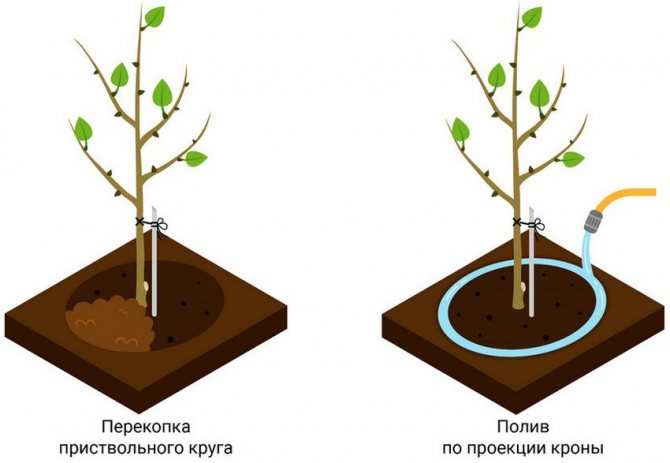

Only clean and settled water is used for irrigation, and in the summer it must be warmed up to ambient temperature in order to avoid hypothermia of the root system
Top dressing
Within 1 year after planting, cherries do not need fertilizing, therefore, they begin to fertilize the tree only from the 2nd year. In the 2nd and 3rd season, cherries are fertilized 3 times. The first feeding is performed during flowering, and then the rest of the feeding is applied at intervals of 10 days. For this, a urea solution is used at the rate of 30 g / 10 l of water. Working fluid consumption - 10 l / plant.
Important! In the 1st year of flowering, it is recommended to cut off all inflorescences from the cherry - this will help the plant to direct all its forces towards effective rooting.
In the 4th year, the tree is fertilized twice: in early spring and in the second half of August. In the spring, 150 g of carbamide is introduced into the trunk circle, in the fall - 300 g of superphosphate and 150 g of potassium sulfate. Mineral fertilizers are carefully instilled into the soil, after which 10 liters of water are spilled on the site.
By the 5th year, a stable feeding regime is created for the tree. In early spring, 150 g of carbamide is introduced into the trunk circle, and in September each cherry receives 400 g of superphosphate, 200 g of potassium nitrate and 4–5 kg of humus.
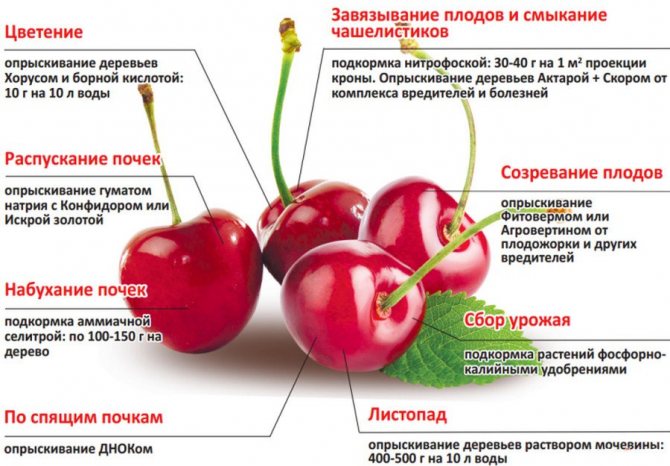

Whitewash
Whitewashing the trunk of a sweet cherry is not a vital procedure, but most growers advise to resort to it. She is allows you to protect the tree from a variety of pests, as well as avoid sunburn of the bark... This is especially important for young plants, the covers of which are often unable to cope with the intense exposure to solar radiation.
It will be useful for you to read about grafting cherries on cherries in spring and summer.
The first whitewashing is carried out after planting, and then, as the covering layer is consumed, it is renewed. For whitewashing, slaked lime is used, diluted to a semi-liquid state.
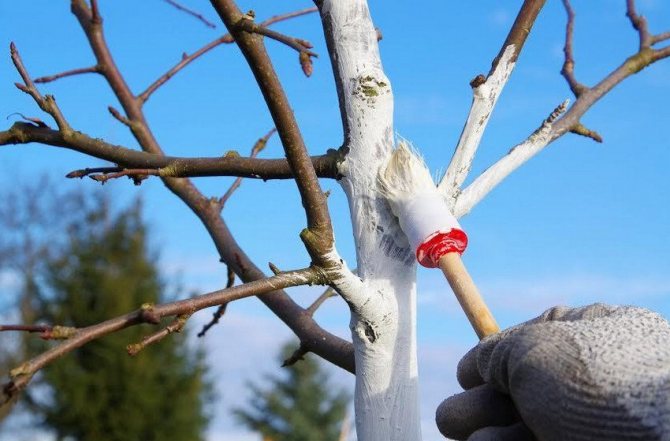

The entire stem of the plant is whitened, starting from the root zone and ending with the first tier of branches
Pruning
Cherry pruning is started already in the 2nd year after planting. This helps to form a compact, fertile crown with the maximum number of fruit branches.
Important! Sweet cherry Bryanskaya Pink requires a pollinator on the site. The best varieties for this are Iput, Tyutchevka, Revna and Ovstuzhenka.
Pruning is carried out so as to give the crown of the tree a tiered shape with a sparse structure. In this case, the lower tier is formed from 3 branches, the middle one - from 2, and 1 vertical stem is left at the top. All other side ramifications are removed, while when the tree reaches a height of 3 m, the top is pinched.


Starting from the 5th year, the cherries are sanitized and thinned. Extra, old, dry and damaged branches are subject to removal. Regardless of the type of pruning, this procedure is carried out in early spring, before the leaf buds open.
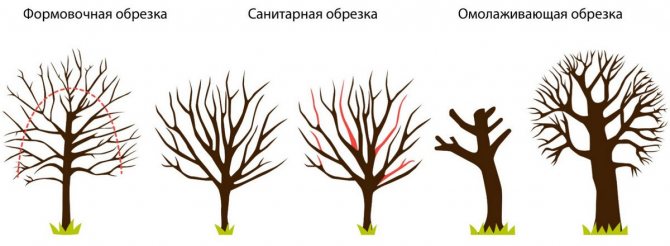

Preparing to disembark
Pollinators should be purchased before planting this tree. Since it is barren, one of the following cherry varieties should be planted at a distance of 7-10 meters from it:
- Jealous;
- Iput;
- Tyutchevka;
- Ovstuzhenka.
Photos of the varieties are presented below.
The flowering and fruiting times of these varieties are identical to the Bryansk rose, which makes it possible for them to contribute to its pollination.
Disembarkation should be carried out on an area with a high level of illumination, while the distance from the trees growing in the neighborhood should be at least 3 meters, and from buildings, at least 4 meters.
The soil for planting a plant must necessarily be fertile; planting on loam would be a good option.
It is imperative to check the level of groundwater, at the place of planting the tree, it should not exceed 2 meters.
It is recommended to drain the bottom of the planting pit with large pebbles; it should be laid in a layer of 5-7 centimeters.
It is necessary to plant seedlings in open soil at least 2 years old, they should be bought from time-tested suppliers and must be inspected before buying.The seedling should have a height of 140 to 170 centimeters, the main conductor should be characterized by a high level of strength. Should be checkedso that the seedling has at least 3 branches.
The roots of the seedling must be well developed and contain at least 4 branches. Make sure there are no dried or rotted areas on the scions.
Before planting a seedling in the soil, its roots must be lubricated with a pre-prepared mixture of manure and clay (for preparation, a kilogram of clay and 500 grams of water and manure are taken). After combining the components, the mixture should have the consistency of thick sour cream. The root part of the seedling is smeared with this mixture and left in this form for 2-3 hours.
Diseases and pests
Despite the increased resistance of the Bryanskaya Rosovaya variety to a variety of diseases, probably every gardener encounters the problem of ailments. There can be a lot of reasons for the occurrence of pathologies, but this problem often arises in case of non-observance of the conditions for growing a culture. Excessive humidity, unregulated fertilization, as well as an unfavorable neighborhood can cause damage to the tree by dangerous microorganisms and harmful insects.
Learn more about combating cherry diseases.
The main diseases of culture are considered to be moniliosis, coccomycosis, chlorosis and ascochitis... When these ailments appear, the cherry should be sprayed 1-2 times with the preparations "Abiga-Peak" or "Hom". Alternatively, you can use a 1% Bordeaux mixture solution.
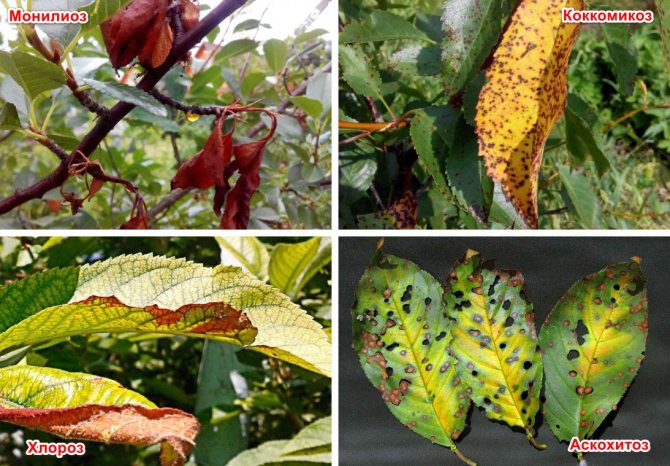

Also among the plantings there are gommosis and fruit rot... They fight these ailments by treating the affected plants with 1% copper sulfate. For prevention, once a month, cherries are also sprayed with 1% copper sulfate or Bordeaux liquid. The drug "Hom" will serve as a more reliable protection.
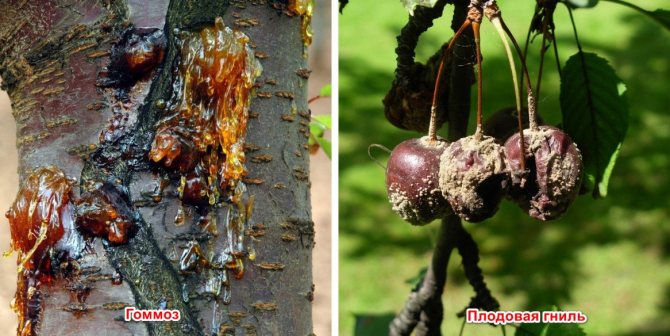

Of the pests, the greatest danger to cherry plantations is aphid and sawfly... Treatments with Aktelik and Inta-Vir are considered the most effective against aphids. The treatment is carried out twice, with a break of 14 days. A solution of 10 liters of water and 250 g of tobacco dust, which is also abundantly sprayed on the diseased plant, is considered safer for the plant. And against the sawfly will help insecticides "Pyriton" or "Iskra-M", with a flow rate of working fluid in the range of 3-4 l / adult tree.


To prevent pest attacks, once every 25 days, the plantings are optionally treated with Fitoverm, Askarin, Iskra, or interchangeable analogues. Also, in order to prevent the appearance of leaf buds, the trunk and branches of the sweet cherry should be sprayed with a concentrated solution of urea. Prepare it from 10 liters of water and 700 g of the drug.


Sweet cherry Bryansk pink: the history of appearance
From the name it is clear that the plant was bred in Bryansk, or rather, in the village of Michurinsky, Bryansk region. Cherry Bryanskaya pink is a seedling of the variety Black Muscat (earlier it was called Negritenkom). The breeding work was carried out by the employees of the Federal State Budgetary Scientific Institution VNII A.I. Astakhov and M.V. Kanshin, for whom the authorship of the new variety was assigned.
In 1987, Bryanskaya rosea was sent for the State variety testing, and six years later it was entered into the State Register of Plants, zoning in the Central Region.
The Bryanskaya rozovaya variety was entered into the State Register in 1993 and zoned for the Central Region of Russia.
Harvesting and storage
Bryanskaya Pink berries are harvested in the middle or end of July. By this time, the fruits are gaining juiciness and acquire a characteristic pinkish-yellow hue. Berries often ripen unevenly, so for the entire ripening period, fruits can be harvested up to 3 times. They are removed carefully so as not to damage the pulp, otherwise the keeping quality of the crop decreases significantly. If possible, it is necessary to clean the crop from stalks, ovary residues and other contaminants.
The berries are harvested in small containers made of plastic, wood or metal, then transferred to common boxes. After collecting them, they must be thoroughly washed under running water, and then sorted out. Whole and undamaged fruits are selected for long-term storage, and the rest require immediate processing. At a temperature of + 5 ... + 7 ° C, cherry berries can be stored for up to 2 weeks after picking. If the crop is harvested slightly unripe (5-7 days earlier), then under such conditions it will be able to successfully maintain its freshness for up to 3 weeks.
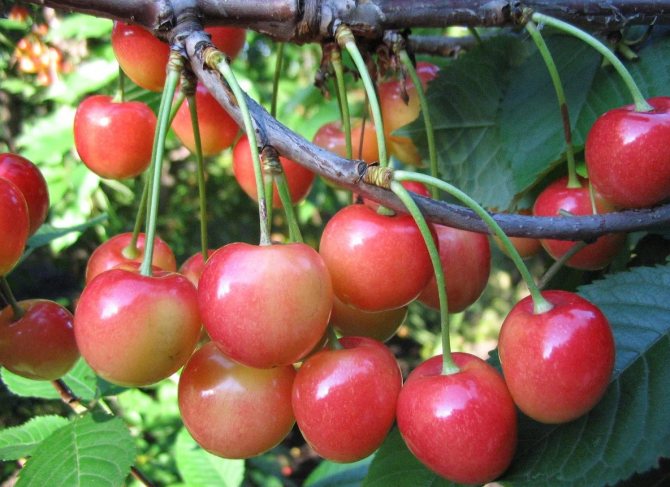

In favorable years, about 40 kg of berries can be obtained from one sweet cherry of the Bryanskaya pink variety
Bryanskaya Rosovaya is a high-yielding and unpretentious variety of table cherries, perfectly adapted for growing in hot and cold climates. This plant is compact, early maturing, so it can be successfully grown both on an industrial scale and for private farming. The main secret of successful cultivation and reproduction of this plant is high-quality care - this is the only way to achieve maximum productivity from cherries.
Advantages and disadvantages
Bryansk pink cherry has both advantages and disadvantages. The positive traits of the tree include:
- good frost resistance (up to 28 ° C);
- high immunity of the tree to coccomycosis;
- stable harvest;
- good transportability of fruits.
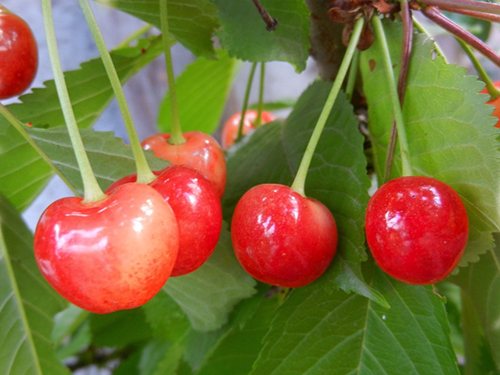

The berries of the Bryansk pink cherry are small but sweet
The disadvantages of the tree include the average size of the berries, the average yield and the inability of the tree to self-pollinate. So, when deciding to plant this cherry, it is worth carefully weighing the pros and cons.




